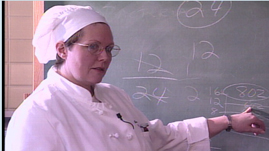Teachers' Domain - Digital Media for the Classroom and Professional Development
User: Preview



In everyday life, there are many occasions when you will need to measure something. Knowing some basic equivalencies will help you to change a measurement from one unit to another. Benchmarks can be used to estimate a unit of measure.
This video segment originally appeared in KET’s GED Connection series.
These resources are part of KET's Measurement and Geometry collection.
In many situations that you encounter in daily life, you need to be able to change a measurement from one unit to another. Most of us know how to convert inches to feet or feet to yards. There are 12 inches in one foot. To convert 36 inches into feet, all you have to do is divide by 12.
But there are some units of measurement that may not be as familiar to you. How many teaspoons are in a tablespoon? How many tablespoons are in a cup? How many cups are in a gallon?
Suppose you want to make three gallons of lemonade to take to your daughter’s soccer practice. The label on the can of powdered mix says the entire container will make 14 quarts. Do you have enough mix to make three gallons of lemonade? Knowing how to convert gallons and quarts to like units will help you solve problems like this one. When you practice converting measurements to like units, you will find that different measures are equivalent.
Sometimes you may not have a measuring tool with you, though. In those instances, it is helpful to have a benchmark as a reference to estimate the unit of measure. For instance, the width of two fingers is a good benchmark for an inch. An ounce is about the weight of an envelope, and a carton of yogurt is about a cup.
If possible, bring several types of measuring tools for learners to identify, i.e., various sizes of measuring cups and spoons, scales, tape measures, rulers, and yardsticks. Discuss the ones that are familiar. Explore conversion and equivalencies among the different measures.
Have learners visit the Meals for You website at http://goo.gl/JGI65. Tell them “In this task, you will visit a web site that calculates a recipe based on the number of servings you want to make. The recipe is for California Primavera, a pasta dish.”
Learners will see a page which shows the recipe for 4 servings. Have them copy down the amounts of the ingredients that the recipe specifies.
Then have learners select "2 servings" from the My Preferences option located at the right of the recipe. How did the measurements change? Try other numbers of servings to see changes in measurement.
For another interactive exercise in measurement, visit KET's Scale City at http://goo.gl/GfKza. The Sunnyside Up activity will give your learners practice in scaling up ingredients. Download the guide for instructions for this activity.
Have learners create their own personal benchmarks for three measurements and then share with others.
 Loading Standards
Loading Standards